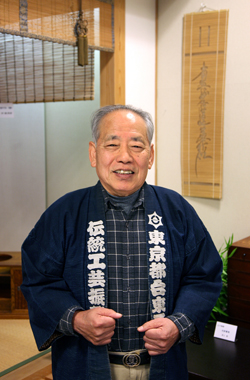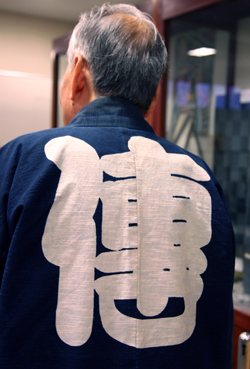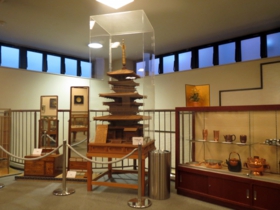
Yoshihiro Tanaka, a chairman of the traditional crafts promotion association in Taito City

We talked with Yoshihiro Tanaka, a chairman of "Taito-ku Dentokogei Shinko-kai (traditional crafts promotion association)" in Taito City.
Q: How and when was this Edo Shitamachi Traditional Crafts Museum established?
We have belonged to an organization called "Taito-ku Dentokogei Shinko-kai (traditional crafts promotion association) in Taito City." Since, in nature, traditional crafts are made by individuals and it is a household industry, I thought, a place where traditional crafts are showcased and people meet one another was needed, so 5-6 colleagues and I opened this gallery in around 1975. Then, the number of craftsmen involved in the gallery has gradually increased. Now, about 80 craftsmen take part in the gallery.
We held an exhibition "Gendai-ban Shokunin-zukushi," or modern craftsmen, at MATSUYA ASAKUSA in around 1980. The store manager of MATSUYA ASAKUSA at that time was Tamio Mori, who is the son of the stationmaster of Asakusa Station on the Tobu Isesaki Line. He used to play in the Asakusa area when he was a child, and some of his friends became craftsmen. Since Mori worked for MATSUYA, his old friends began to have ties with MATSUYA. However, the number of craftsmen has gradually decreased. After Mori became the store manager, Gendai-ban Shokunin-zukushi was held as a comprehensive survey of traditional crafts. Five to six of my colleagues also had a relationship with Mori, so we participated in the exhibition. In Sumida City, the head of the city tried to revive craftsmen's culture and towns, and began to contact with craftsmen. On the other hand, in Taito City, craftsmen, including me, spontaneously began to rally together. These movements led to the first exhibition in 1980. Also, in order to tighten the union of craftsmen, we organized "Taito-ku Dentokogei Hozon-kai," or traditional crafts conservation society in Taito City, a predecessor of "Taito-ku Dentokogei Shinko-kai," in 1981, and asked for support from Taito City. When we thought that just receiving support was not enough, a grocery store located at the Asakusa Hisago shopping street moved to a different area. Then, Taito City obtained the site, and the Edo Shitamachi Traditional Crafts Museum was established at the site with support from the chairman of the city assembly.
Q: In the present, how many craftsmen participate in Taito-ku Dentokogei Shinko-kai? Also, how are traditional crafts designated by Tokyo?
There are about 100 craftsmen at the most. Some craftsmen died, but some young craftsmen have newly participated in the association. Not only craftsmen in Taito City, but craftsmen in neighboring cities have also participated in the association.
40 products have been designated as the traditional crafts in Tokyo. The traditional crafts must meet the following requirements: use of traditional skills and techniques, homemade crafts, and use of materials that have traditionally been used. Nationally-designated traditional crafts should also meet similar requirements.
For example, pine and cypress have been used for traditional crafts from old times, but plywood is a new material, so it cannot be used for traditional crafts. For metals and nonmetals, gold, silver, copper and tin can be used, but new materials, such as aluminum, nickel, plastic and resin, cannot be used. For fibers, cotton and silk can be used, but synthetic fibers cannot be used. In this way, we have carried out the preservation of traditional techniques and histories.
Q: Do you never use new materials?
Yes, we occasionally use new materials. For example, in some cases, new materials, such as plywood , are used as parts of cabinetwork, but the parts must be out of sight. In my studio, new materials are rarely used for making bamboo blinds. Although I have tried to use new materials to produce modern expressions, traditional domestic materials, such as bamboo and reed, are better. (continued in the right column)
Q: I have frequently heard the word "Edo-fu or Edo-mono," or Edo-style. What kind of product is it?
There have been a variety of traditions and expressions since the Edo Period, which are similar to trends in each period. For example, "Edo-mae Sushi," or Tokyo-style sushi, refers to sushi made in Tokyo. Originally, Kyoto was the center of traditional crafts and textile dyeing in Japan, and later they were introduced to Edo, so their expressions in Tokyo are slightly different from those of Kyoto. Taking bamboo blinds as an example, since Kyoto lies on a basin, summer in Kyoto is very hot, so shading a room by bamboo blinds is an expression of coolness. Therefore, bamboo blinds are hung from the top of windows or rooms to the bottom, extending to floors. On the other hands, in Edo, there are the Bay of Tokyo and the Sumida River to the southeast, and cool breezes blow in from the bay and river, so bamboo blinds are made slightly short and slimly. By doing so, bamboo blinds sway in the wind, so the wind can be visualized. In nature, you cannot see the wind, but can perceive that there is the wind. It is said that people in Edo clean the exterior of houses, but, in Kyoto, people clean the interior. Therefore, expressions in Edo are opposite from those in Kyoto. Structures of houses are also opposite.
Q: An atmosphere of Edo-style is considerably different from that of Kyoto-style, isn't it?
Yes, it is. They are quite different from each other. Many Japanese traditional expressions and structures were originally introduced from Kyoto, but the expressions have changed in accordance with differences of regions and cultural climates. For example, lacquerware can be smoothly coated in Kyoto, but genuine lacquerware cannot be made in the Kanto region because the dry wind blows and the air is dry. Other materials can dry in the wind and the sun, but lacquerware dries only at appropriate humidity. Therefore, the hub of lacquerware has been Kyoto. For other crafts related to lacquer, a climate of basins, for example, those of Yamanaka-machi in Ishikawa Prefecture and Aizuwakamatsu City in Fukushima Prefecture, is suitable.
Measurements also differ between different regions. For example, 1 ken in Kyoto is the distance between two pillars' outer edges, and 1 ken in Tokyo is called "Hashira-wari," the unit measured between two pillars' cores. The length of a tatami mat in Kyo-ma (measurement used for bay size in the Kansai region) is 1,910 mm, Chukyo-ma (measurement in the Chukyo region) is 1,820 mm, and Edo-ma (measurement in the Kanto region) is 1,760 mm, and based on those tatami mat sizes, houses are constructed. Therefore, when I brought tatami mats made in Tokyo to Kyoto, the mats did not fit into rooms. In the present, bearing that in mind, tatami mats are produced, so such problem does not arise.
Q: When I asked craftsmen and furniture makers about measurement, they answered that they have still used the shaku measurement system instead of the metric system. What about in the field of traditional crafts? I heard that there were many problems due to the abolition of the shaku-kan system. Are there still some problems?
Note: The shaku-kan system of measurement had been widely used in East Asia, which measures length in shaku and weight in kan. In Japan, it was abolished between 1958 to 1966 by the Measurement Law. However, the shaku-kan system has still been approved for use in traditional fields. 1 shaku in Japan is approximately 303.030 mm, and in China it is approximately 333.333 mm.
In my case, I am more familiar with the shaku measurement system, but I can use both measurement systems: the shaku and metric measurement systems. The most troublesome time was the postwar years. The unit of an inch was used after the war, so it was difficult to accurately measure. Although I converted inches to shaku or centimeters and made bamboo blinds, but fractions were left. I have still used shaku rulers because they are useful. For example, calculations, such as dividing by 3, can be easily done by using a shaku ruler. However, it cannot be done by using a ruler with the metric system.
Q: Is an atmosphere of Edo-style still different from that of Kyoto-style? Is there any traditional craft that have been developed in Edo?
For example, the tea ceremony and tea utensils were originally produced in Kyoto, so the tea ceremony is still held in the Kyoto style. In Edo, "Yukata," or informal cotton kimono, was contrived. Also, "Edo-comon," or fine pattern on formal clothing, is slightly different from "Kyo-common." Designs and textiles have independently been developed, according to each region's characteristics. Other traditional crafts have also been developed in that way.(continued in the next page)

Yoshihiro Tanaka, a chairman of the traditional crafts promotion association in Taito City













